Artists
For Her Blue-Chip Gallery Debut, Rising Artist Brook Hsu Paints Her Own Vision of the Wild West
Brook Hsu brings viridian visions of her home state of Oklahoma to New York's Gladstone Gallery.
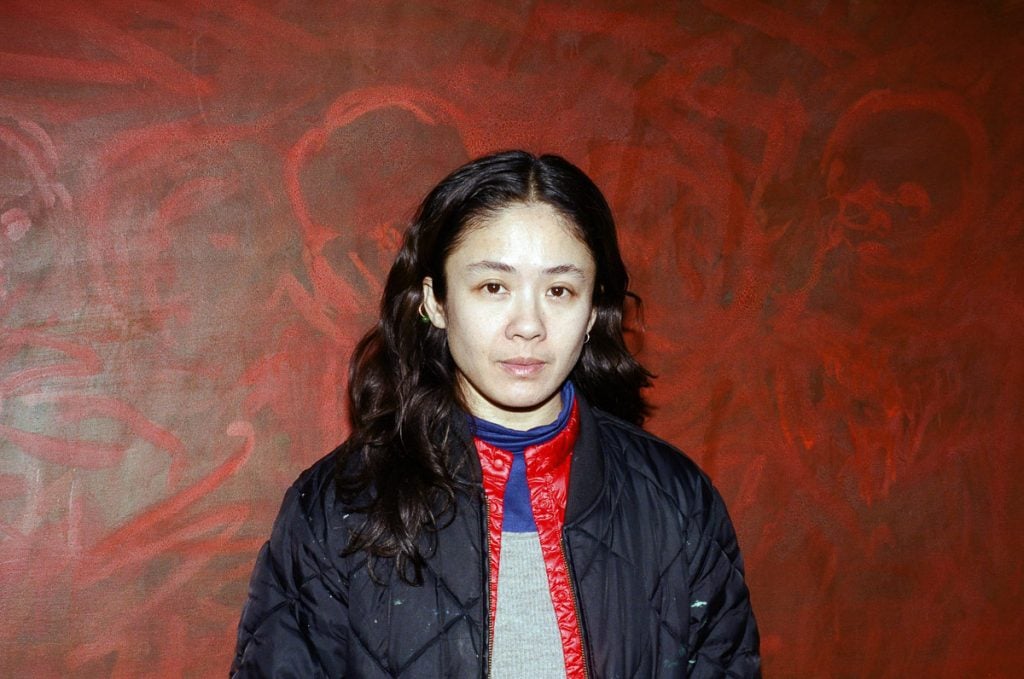
“It was a bit of a Proustian adventure, what happened to me,” said Brook Hsu during a recent conversation. Hsu was talking to me on a video call from her home in Wyoming. She had recently put the finishing touches on the works for her much-anticipated new solo exhibition “The Oklahoma Nature Theater,” which opens at Gladstone in New York today.
Hsu (b. 1987) has been on the rise in the art world for the past few years and is known for her deeply nuanced approach to painting and in-depth art historical engagements, which she often explores on her Instagram. Since earning an MFA from Yale University in 2016, she’s been the subject of numerous solo exhibitions at respected galleries including Bortolami in New York and Manual Arts in Los Angeles. But this exhibition feels like a moment of arrival. “The Oklahoma Nature Theater” is her first New York show with Gladstone, following an intimate 2022 exhibition at Rome’s Sant’Andrea de Scaphis that was organized by the gallery.
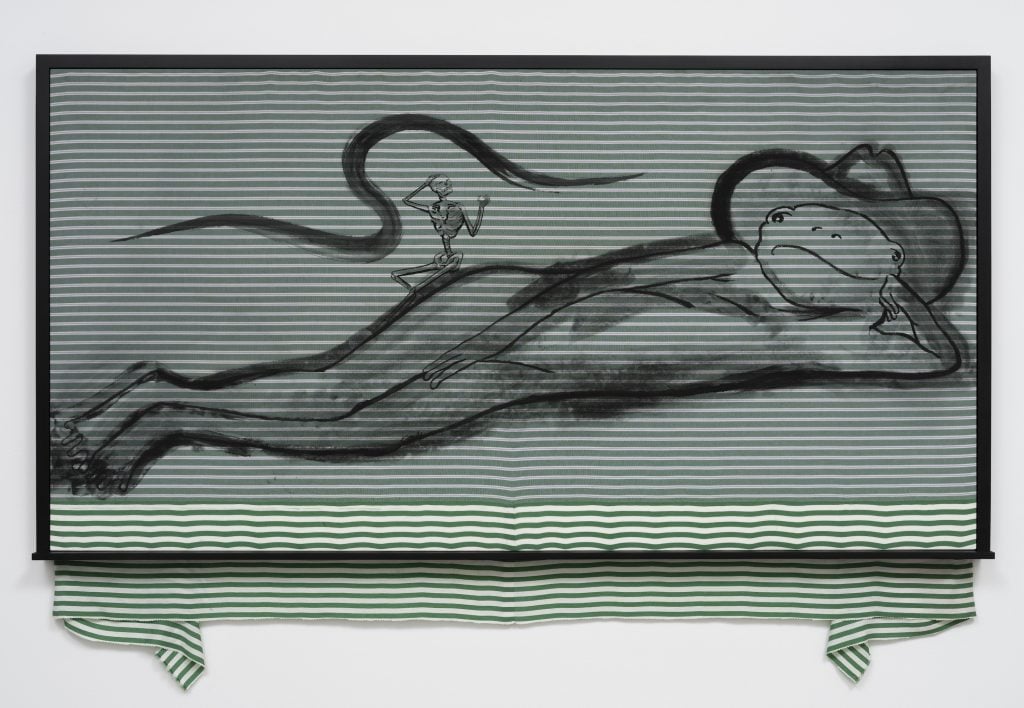
Brook Hsu, In the Frog World It’s OK! (2024). © Brook Hsu. Courtesy of the artist and Gladstone Gallery. Photo: David Regen.
The show’s works, 14 of them made over the past year, are materially experimental, ranging from small oil paintings on wood to ink on canvas to fabric and ink on canvas examples, a more recent development. The artist is known for her almost stubborn devotion to small-scale paintings and her bold embrace of a viridian green palette, which gives her paintings a quality both organic and almost toxically alien.
But Hsu, an Oklahoma native who spent years living in New York, has been pulled back West, both physically and artistically, and here explores the visual language of the American West and its legacy. For instance, in one of the new works, In the Frog World It’s OK!, a cartoon frog in a cowboy hat lounges in languorous repose. The image is comic but oddly familiar. Have I seen this frog before, I wondered. Hsu’s works have that effect sometimes, teetering on the edge of a memory that might give way to another memory, like falling through a well in your mind, the story expanding.
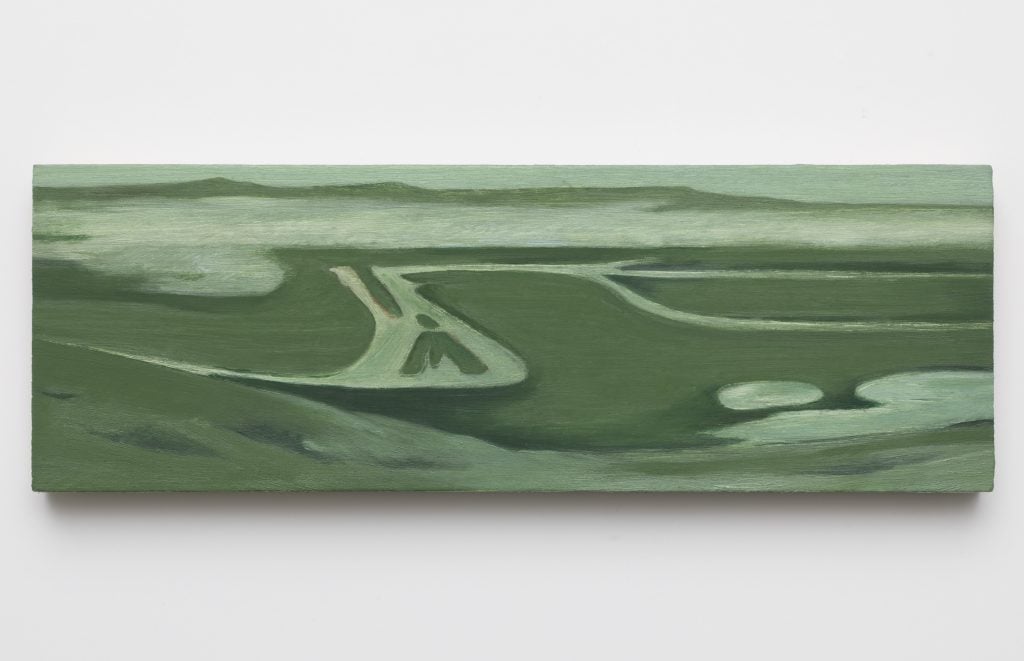
Brook Hsu, View of the Green River From the Pinedale Anticline (Trapper’s Point) (2024). © Brook Hsu. Courtesy of the artist and Gladstone Gallery. Photo: David Regen.
The artist experiences those sensations too. The press release for “Oklahoma Nature Theater” comes in the form of a short story by the writer Amanda Schmitt. In the story, an unnamed woman painter, who we can assume to be a fictionalized version of Hsu, sits on a mountainside with a man, her lover, and ponders, “How did I get here as a painter? As an artist? All of these hundreds of years of history and painting, culminating upon me, and I find myself painting the image of a sexy frog in a cowboy hat, over and over, on repeat. What does this have anything to do with Titian or Poussin, Holbein or Cole?”
But it all does, in some form, tie together, through a “Proustian adventure” which carried Hsu back to Oklahoma and Wyoming. One day almost a year ago, she was looking at the work of the post-war German artist Martin Kippenberger. Hsu has been influenced by a sweep of German painters, from 19th-century landscapists to the postwar era. But she had never fully connected with Kippenberger’s work and was trying to find a way in.
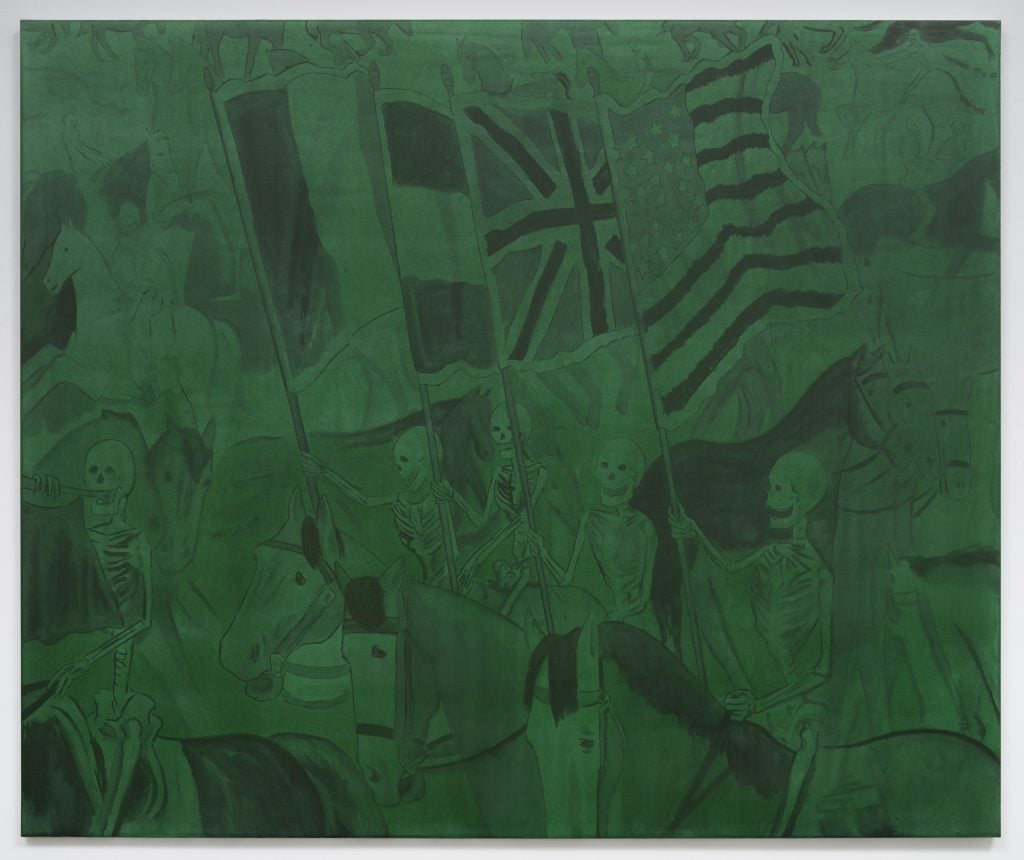
Brook Hsu, The Oklahoma Nature Theater (2024) © Brook Hsu. Courtesy of the artist and Gladstone Gallery. Photo: David Regen.
“I was looking at Martin Kippenberger’s last work, The Happy End of Franz Kafka’s ‘Amerika,’” she said, describing the work as an installation “on a vast green floor with all these different furniture arrangements.” Looking at the work, which Kippenberger made in 1994, three years before his untimely death at age 44, Hsu felt compelled to read the end of Kafka’s novel, which the Czech author penned between 1911 and 1914.
“The main character finds himself just stumbling through life and ends up in America,” she explained, “He winds up seeing this ad for work at the Great Nature Theater of Oklahoma. The advertisement says that they hire everyone, anyone can come. So he goes on an interview and is shuffled through all these different tents. Horses are everywhere.”
The story startled Hsu, with Oklahoma offering a direct link between Kippenberger, Kafka, and, herself. The story also made her remember a poster she had in her childhood kitchen. “It was for the Pawnee Bill Wild West Show. I couldn’t get it out of my head,” she said. “I kept thinking: Did Kafka see a Wild West show? Where was Oklahoma in this story? It spurred all these questions centered on an ambivalent object of my childhood.”
Hsu’s childhood poster was long gone, and the artist couldn’t find any record of it online. Eventually, she tracked down the original at the Pawnee Bill Ranch, not far from where she grew up. “I went and looked at the original poster,” she said. “I drew from it. I took pictures. I talked to a lot of historians, including the head of the Oklahoma Historical Society.”
The historian suggested Hsu head to Cody, Wyoming, to visit the Buffalo Bill Wild West Museum for more answers. There Hsu learned that Buffalo Bill’s Wild West did travel to Germany as well as Austria-Hungary during the years of Kafka’s childhood and was well-received.
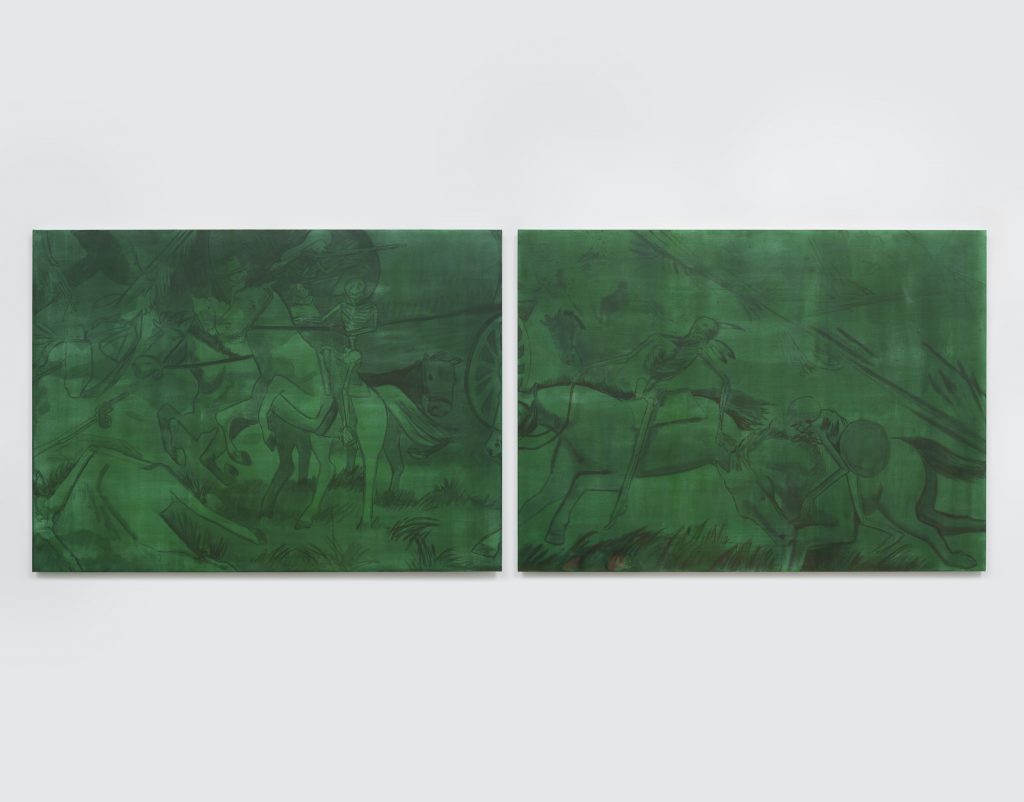
Brook Hsu, Good-Bye Hannah (2024) © Brook Hsu. Courtesy of the artist and Gladstone Gallery. Photo: David Regen.
“All these narratives kept tying into more narratives, making links between the history of painting as well as my own story,” she said. “It was almost random to me that I grew up in Oklahoma, but it’s a big part of me, too. Even though I left when I was 19, the place still feels so present in all of my works no matter what.”
For the past two years, Hsu has been living part-time in Pinedale, Wyoming (she still keeps a studio in New York) and has spent countless hours reading at the local library. There, the local art books are mainly rooted in Western expansion, she told me. “The first images of the West, which helped establish the national parks and helped advertise for Western expansion, are often credited to the influence of British painters, to Turner and Constable. But there was a connection, for some of the artists, to Albert Bierstadt, and the German academy and history painting. Germany and Americans have these repeated exchanges.”
In the works that have arisen from this stew of research, she pulls from everything from her own interpretation of Thomas Cole’s 1826 painting View from Mount Holyoke, Northampton, Massachusetts, after a Thunderstorm—The Oxbow to a reference to the scene in The Silence of the Lambs in which Hannibal Lecter tells Clarice to see Titian’s Flaying of Marsyas (1570-76) at the National Gallery of Art. They also reference landscapes with which Hsu has directly interacted. (It might be surprising to some that these paintings are the first time Hsu is painting real, rather than imagined, landscapes).
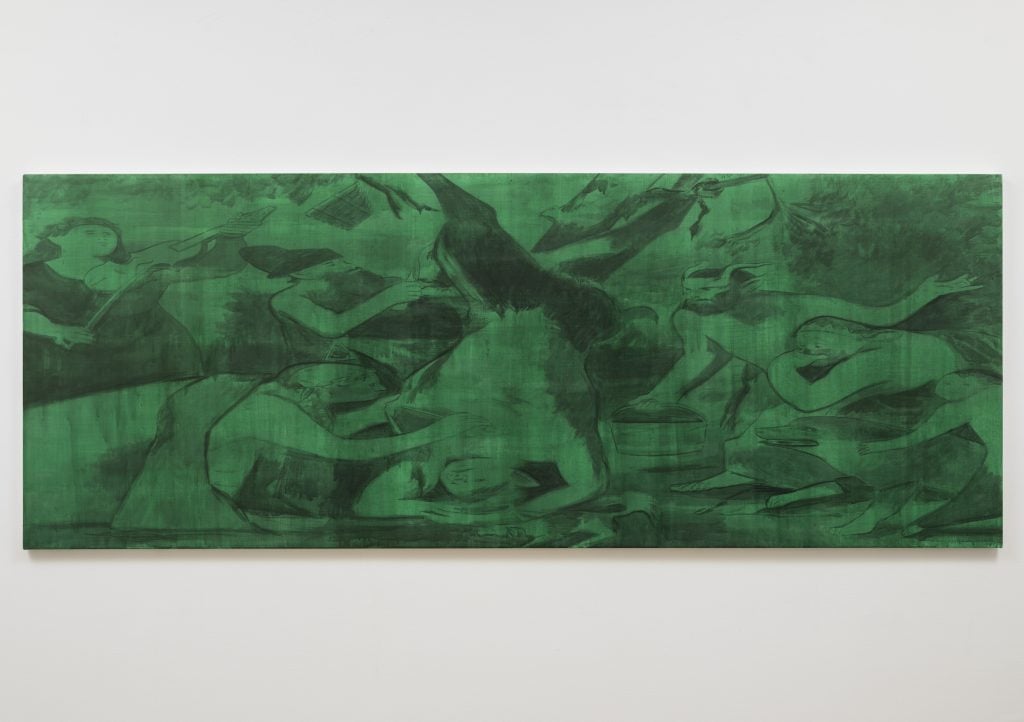
Brook Hsu, Flaying of Marsyas (2024). © Brook Hsu Courtesy of the artist and Gladstone Gallery. Photo: David Regen.
One painting shows Trapper’s Point in Wyoming, a conservation site that is also one of the world’s largest natural gas reserves. “One side has been fracked for natural gas and the other side is a conservation site that preserves the last large mammal migration path for the pronghorn antelope. People have been going there for thousands of years to hunt,” Hsu explained. “But it was also where my boyfriend asked me to be his girlfriend.”
Such intimate allusions are hidden throughout her works. Coming away from our conversation, I had the thought that while Hsu is a painter, in her own way, she is really a storyteller, a mythmaker whose stories fold in on themselves, overlap, and unfurl. She is, in conversation, so easy to listen to, the cadence of her voice, rhythmic and lulling, like wind rustling a field of wheat. Hsu is a child of the prairie, and her paintings are, in real ways, a portrait of America, at once frightening, majestic, lonely, and vaudevillian, that she relates to us beside a campfire and under a sky full of stars.





